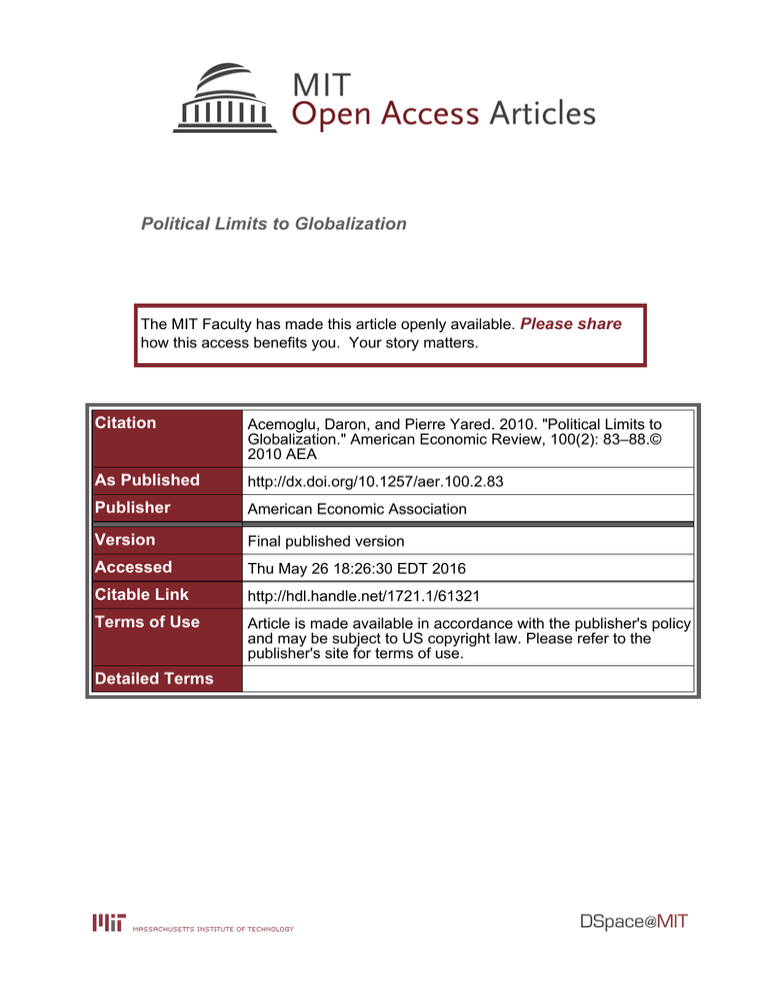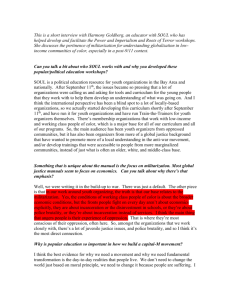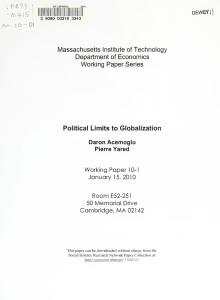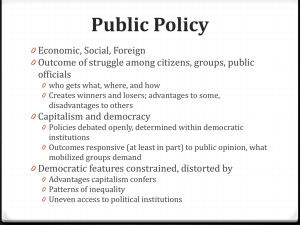Political Limits to Globalization Please share
advertisement

Political Limits to Globalization The MIT Faculty has made this article openly available. Please share how this access benefits you. Your story matters. Citation Acemoglu, Daron, and Pierre Yared. 2010. "Political Limits to Globalization." American Economic Review, 100(2): 83–88.© 2010 AEA As Published http://dx.doi.org/10.1257/aer.100.2.83 Publisher American Economic Association Version Final published version Accessed Thu May 26 18:26:30 EDT 2016 Citable Link http://hdl.handle.net/1721.1/61321 Terms of Use Article is made available in accordance with the publisher's policy and may be subject to US copyright law. Please refer to the publisher's site for terms of use. Detailed Terms American Economic Review: Papers & Proceedings 100 (May 2010): 83–88 http://www.aeaweb.org/articles.php?doi=10.1257/aer.100.2.83 growth in a partially de-globalized world† Political Limits to Globalization By Daron Acemoglu and Pierre Yared* We live in an unprecedented age of globalization, where technology, ideas, factors of production, and goods are increasingly mobile across national boundaries. The current wave of globalization is distinguished from previous ones in part because of the major role of information technology. Nevertheless, globalization is not irreversible. Openness to international trade, finance, and technology is a choice that countries make, and despite the facilitating role of information technology, many countries, even many leading players in the world economy including the United States, China, India, Brazil, and Russia, could decide to close their borders. A major cause of the end of the previous (also historically unprecedented) nineteenth century wave of globalization was disillusionment with the international economic order, in large part precipitated by the Great Depression (e.g., Harold James 2001). Another, somewhat less emphasized though not necessarily less important cause was the rise of nationalism, militarism, and international conflict (e.g., Ronald Findlay and Kevin H. O’Rourke 2007, Reuven Glick and Alan M. Taylor 2005).1 The previous wave of globalization took place in the context of the 100 years following the end of the Napoleonic wars, which were unusually peaceful for European powers; it came to an end following the most widespread conflict that human society had experienced until then, World War I. In this paper, we emphasize that globalization, which depends on political decisions of nation states, has political limits, and that these limits are related to nationalism and militarism. Despite the increasing reach of globalization, anecdotal evidence suggests that nationalism and militarism are strong around the world, in countries ranging from the United States to China, Russia, and India (e.g., Robert Kagan 2008). To go beyond anecdotal evidence, in this paper we proxy nationalist and militarist sentiments by military spending.2 In addition to being a useful proxy, military spending might itself impact trade, for example, because it contributes to tensions or leads to skirmishes between countries. Figure 1 shows the evolution of world trade and total military spending between 1988 and 2007. It depicts the steady rise of trade over the past two decades, during which we have data on military expenditures and the quantity of military personnel across a large number of countries (as is well known, the increase in the volume of trade during this time period reflects longer term trends, e.g., Findlay and O’Rourke 2007). It also shows that military spending, after declining for a number of years, started increasing from the mid-1990s onwards. This pattern indeed indicates that there might be more than anecdotal evidence pointing to a strengthening in nationalist sentiments and militarism. Our main contribution in this paper is to show that military spending, in our interpretation as a † Discussants: A. Michael Spence, Stanford University; Philippe Aghion, Harvard University. * Acemoglu: Massachusetts Institute of Technology and Canadian Institute for Advanced Research, 50 Memorial Drive, Cambridge, MA 02142 (e-mail: daron@mit.edu); Yared: Columbia University, 3022 Broadway Ave., New York, NY 10027 (e-mail: pyared@columbia.edu). We would like to thank Philippe Aghion, Alex Debs, Philippe Martin, Thierry Mayer, Kevin O’Rourke, and Mathias Thoenig for suggestions and Dmitriy Sergeyev for excellent research assistance. 1 Militarism is defined as the doctrine or policy of “aggressive military preparedness,” which typically leads to a country’s maintaining a strong military capability to defend or promote its national interests. 2 This is true almost by definition of militarism. Tom W. Smith and Lawrence Jarkko (2001) provide several measures of “national pride” constructed from survey evidence, some of which are strongly correlated with military spending across countries. 83 84 MAY 2010 90 1,500 Trade share of GDP Trade Military spending 1,400 80 1,300 70 1,200 60 1,100 50 1,000 1990 1995 Year 2000 Military spending in billions of dollars AEA PAPERS AND PROCEEDINGS 2005 Figure 1. World Trade and Militarization, 1988–2007 Notes: Sample is a balanced panel 1988–2007 for which trade share of GDP and military spending is available for all years. Trade share of GDP is the average across countries for each year. Military spending is the sum across countries and is in 1996 dollars. For reasons of data availability, military spending for Russia and China in 1989 is assigned to 1988; 1991 military spending for Russia is interpolated; and 1990 openness for Russia is assigned to 1988 and 1989. See text for data definitions and sources. proxy for nationalist sentiment and militarism, is negatively associated with trade. We present two types of evidence. First, we show that between 1985 and 2005, countries that experience a greater increase in military expenditure or the size of the military show a relative decline in the volume of trade (compared to other countries in the sample). Moreover, countries whose trading partners (“neighbors”) show greater increases in military expenditure or the size of the military also show a similar decline. These patterns are robust across different specifications and in different subsamples. Second, we investigate bilateral trade patterns again between 1985 and 2005. The data suggest that trade between two countries grows less rapidly when both become more militarized. While not as robust as the first set of findings, this pattern is generally present in a variety of different specifications. In summary, the data point to a negative correlation between militarization and trade. Although we cannot ascertain a causal relationship, the evidence is broadly consistent with an association between the strength of nationalist sentiments and militarism, as proxied by military expenditures or the size of the military, and international trade. Overall, this evidence suggests that there might be political and military limits to, and dangers against, globalization. Our paper is related to three separate literatures. First, several studies in economic history have investigated the causes of the end of the nineteenth century globalization (e.g., James 2001, Barry Eichengreen and Douglas A. Irwin 2009). Second, there is a large and growing literature in international relations on the so-called “liberal theory,” based on ideas first articulated by Montesquieu and Kant, that greater trade makes war less likely (see, for example, John R. Oneal and Bruce Russett 1999, Solomon William Polachek 1980). Several papers in this literature have simultaneously estimated the effect of trade on war and of war disruptions on trade (e.g., Philippe Martin, Thierry Mayer, and Mathias Thoenig 2008, or Havard Hegre, John R. Oneal, and Bruce Russett forthcoming), and find a negative effect of war on trade. It is worth noting, however, that the effect of militarization we focus on is distinct from this disruption effect, and we demonstrate this by showing that the effect survives when all countries or country pairs engaged in military conflict are excluded from the data.3 Finally, our paper is also related to Anna Maria Mayda and Dani Rodrik (2002) and O’Rourke and Richard Sinnott (2001), who document a negative relationship between ­attitudes towards trade and nationalist sentiment in survey responses. 3 Due to space restrictions, we do not describe these results in detail and we refer the reader to the working paper for more information. Political Limits to Globalization VOL. 100 NO. 2 I. Data Our measure of trade (openness) is a country’s trade share of GDP in constant prices from Summers-Heston dataset, 2002. We use this same dataset to measure real GDP per capita and total population.4 Bilateral trade data are from the International Monetary Fund Direction of Trade Statistics, 2009 (DoT) CD-ROM. Let Xijs denote bilateral trade between i and j in year s, meaning the sum of exports from i to j and exports from j to i in year s. We calculate Xijs for all country pairs in year s for which flows both from i to j and from j to i are available. These flows can be measured using either FOB (free on board) exports from i to j or CIF (cost, insurance, and freight) imports by j from i. When both are available, we take the average, and otherwise we use whichever measure is available. Using this measure, we construct a measure of bilateral trade between i and j as a fraction of i’s total trade, and we multiply this measure by i’s trade share from the SummersHeston dataset so as to achieve a measure of the bilateral trade between i and j as a fraction of i’s GDP. Military spending (as a fraction of GDP) is from the Stockholm International Peace Research Institute FIRST Database.5 We multiply this fraction by total GDP using GDP per capita and population from the SummersHeston dataset to create a measure of military spending. Military size measures total military personnel and is also from FIRST.6 Using the military spending and military size data, we construct a measure of the militarization of “neighbors.” Specifically, let ωij represent the inverse distance in kilometers between i’s capital and j’s capital.7 We then calculate a weighted average of the log military spending of country i’s neighbors using the ωij’s as the (relative) weight of country j (≠ i ) in this calculation. We use the same method to calculate the weighted average of the log military size of neighbors. 4 Trade and GDP data are missing for Russia for 1988, so we use the 1989 value. 5 Facts on International Relations and Security Trends Database. http://first.sipri.org/ 6 Military spending in 1988 is missing for China and for Russia, so we use the military spending from 1989 for both observations. 7 Distance between capital cities is from Kristian S. Gleditsch and Michael D. Ward (2001). 85 This measure captures both the militarization of neighboring countries which would pose the greatest military threat to country i and also the militarization of those countries with which country i should trade most heavily according to the standard gravity models. For the regressions using military spending, the beginning date of the sample is 1988, and the end date is 2005. For the regressions using military size, the beginning date of the sample is 1985, and the end date is 2003. These dates are chosen to maximize the number of countries in our sample, given data availability. Finally, as a robustness check we exclude countries that experience a civil or international war between 1985 and 2005. For this exercise, we use the International Peace Research Institute and Uppsala Conflict Data Program Armed Conflict Dataset,8 and we code a country as experiencing a civil war if it experiences an intrastate armed conflict of war intensity, and we code a country as experiencing an international war if it is a primary party in an interstate armed conflict of war intensity. II. Cross-Country Evidence We start with cross-country evidence and investigate the relationship between militarization and trade using the following long-difference regression model: (1) Δyi = αΔmi + Δx i′β + ui . Here Δyi is the change in the trade share of GDP of country i between the beginning and the end dates of the sample; Δmi is the change militarization (i.e., log military spending or log military size) of either country i or of country i’s neighbors; Δxi represents the change in a vector of covariates (log GDP per capita, log population, and Organization for Economic Co-operation and Development (OECD) differential trends in some specifications); and ui is an error term. We focus on long-difference specifications to capture medium run trends as opposed to annual fluctuations. Naturally, this specification is algebraically equivalent to a panel data regression 8 Armed Conflict Dataset. http://www.prio.no/CSCW/ Datasets/Armed-Conflict/UCDP-PRIO/ 86 MAY 2010 AEA PAPERS AND PROCEEDINGS Table 1—Long Difference Results using Total Trade Share Base sample, 1985–2005 Long difference OLS (1) Long difference OLS, excluding Asia (2) Long difference OLS, excluding countries at war (3) Log military expenditure of trading partners Log GDP per capita Log population Country is in OECD Observations R2 −17.585 (6.296) −22.562 (7.053) −24.529 (9.261) −17.144 (6.072) 37.039 (14.318) 17.542 (16.752) 54.382 (15.166) 36.239 (13.906) 13.488 (19.829) −2.626 (22.258) 29.216 (20.314) Log military size of trading partners Log GDP per capita Log population Country is in OECD Long difference OLS (8) Long difference OLS (9) 32.833 (23.892) 12.696 (6.913) −15.342 (6.555) −33.032 (14.259) −36.852 (15.155) −28.506 (16.121) −28.745 (13.157) −21.736 (14.568) 26.841 (15.083) 9.723 (18.802) 36.146 (19.495) 26.151 (14.889) 36.972 (14.125) 15.864 (25.377) 1.302 (28.786) 25.764 (30.054) 29.024 (30.489) 10.125 (7.576) 24.516 (22.453) 92 75 69 92 92 75 69 92 92 0.16 0.23 0.22 0.19 0.11 0.12 0.14 0.13 0.18 −10.006 (4.356) −11.426 (4.797) −8.831 (6.151) −9.939 (4.295) 30.748 (7.793) 25.847 (8.619) 40.541 (7.890) 29.945 (7.965) Dependent variable is trade share of GDP Panel B Log military size Long difference OLS (5) Long difference OLS, excluding countries at war (7) Dependent variable is trade share of GDP Panel A Log military expenditure Long difference OLS (4) Long difference OLS, excluding Asia (6) 11.730 (17.204) −5.696 (18.502) 7.530 (17.501) 30.907 (20.866) 15.618 (6.591) −7.241 (3.887) −59.256 (16.028) −48.796 (13.563) −51.713 (14.304) −55.671 (16.094) −53.396 (15.644) 31.593 (8.327) 26.831 (9.876) 43.514 (8.186) 31.161 (8.444) 32.077 (8.233) 44.909 (22.259) 21.449 (22.181) 39.232 (21.553) 50.180 (23.006) 6.401 (5.752) 47.904 (22.336) Observations 119 99 89 119 119 99 89 119 119 R 2 0.19 0.24 0.27 0.21 0.24 0.26 0.33 0.25 0.27 Notes: Long difference OLS regression in all columns, with robust standard errors in parentheses. Base sample are countries with data for 1988 and 2005 in panel A and for 1985 and 2003 for panel B; columns 2 and 5 exclude Asia; columns 3 and 6 exclude countries experiencing civil or international war. See text for data definitions and sources. with two observations per country and a full set of country and year fixed effects.9 Table 1 reports estimates of equation (1). In panel A, militarization is measured as (log) military spending, while in panel B militarization is (log) military size. Throughout we report standard errors that are robust against arbitrary heteroskedasticity. Column 1 in panel A reports an estimate of α of −17.6 with standard error (SE = 6.3). This 9 The results are similar if the level equation corresponding to (1) is estimated on annual data with a full set of country and year fixed effects. coefficient, which is statistically significant at less than one percent, also implies an economically large effect: a ten percent increase in military spending over two decades, holding all else constant, is associated with a reduction in trade share to GDP of approximately 1.8 percent.10 This result is illustrated graphically in Figure 2, which displays a residual plot of 10 The median country in the sample experienced an increase in log military spending of 0.16 over the sample period. The increase in trade during the same period is captured by the constant (the equivalent of a common “time effect” in a panel regression). The regression is therefore exploiting whether a country’s variation around Political Limits to Globalization Residual change in trade share of GDP VOL. 100 NO. 2 100 KHM ARE 50 −50 ZWE HUN MYS SGP MNG RUS SLV 0 87 MOZ PNG THA JOR IRL NLD BEL ROM POL PHL AUT GHA ZMB MEX MDG DEU SWE GMB KOR TUR FIN CHE KENDNK BDI CMR SYRMAR URY ECU ARG GTM ISR ALBETH ESP TGOSAUCAN FRA CHL COL PRT IND BGD BRA MRT MWI NZL GBR ZAF SEN GRC OMN ITA JPN CHN AUS IDN FJI USA MLI CYP NOR BEN KWT UGA LKA DZA PAK BHR NGA DOM SDN EGY TUN BFA DJI SLE NPL MUS −100 LBN RWA −1 0 1 Residual change in log military expenditure 2 Figure 2. Change in Trade and Militarization, 1988–2005 Notes: Figure corresponds to the residual plot of regression in column 1 of panel A of Table 1. See text for data definitions and sources. coef. = −17.585122, (robust) s.e. = 6.2961775, t = −2.79. trade share ­versus military spending and shows a strong negative relationship. Columns 2–4 explore the robustness of this pattern. In column 2, we exclude Asian countries, many of which have experienced an increase in militarization simultaneously with rapid increases in international trade, which may have had other causes, related to the increasing ability of Western companies to outsource and offshore to Asia. The estimate of α increases to −22.6 (SE = 7.1), confirming that the relationship between militarization and trade is stronger without Asian countries. Column 3 investigates whether our results capture the impact of trade disruption caused by wars; it excludes countries engaged in civil wars or in international wars. Interestingly, our results are stronger once these countries are excluded (coefficient −24.5, SE = 9.3). This bolsters our belief that our results are related to the relationship between trade and militarism. Finally, column 4 includes a dummy for OECD countries, allowing differential trend in trade for this group of countries. Even though OECD countries appear to ­experience faster growth in trade, this has no effect on our estimate of α, which is almost identical to that in column 1. Columns 5–8 are analogous to columns 1–4 but use the log military spending of neighbors, the global trend towards greater trade is due to variation in militarization. as defined in the previous section, in place of mi. In column 5, the coefficient estimate of α is −33.0 (SE = 14.3). This estimate is almost twice that in column 1, suggesting that increases in ­militarization by geographically proximate neighbors are associated with even a larger relative decline in trade. Columns 6–8 show that this pattern is robust to the same set of specification checks as in columns 2–4. Finally, column 9 includes both log militarization of a country and the weighted log militarization of its neighbors. The effect of own military expenditure is very similar to that in column 1 and statistically significant at less than one percent, while the effect of neighbors’ military expenditure is still large but no longer statistically significant. In panel B, militarization is measured as log military size. The results are similar to those in panel A, with a somewhat smaller quantitative effect from own militarization and larger effects from militarization of neighbors. Overall, the cross-country evidence shows a relatively robust association between changes in military expenditure or number of military personnel and changes in international trade between 1985 and 2005. III. Evidence from Bilateral Trade We also studied the relationship between militarization and trade using more disaggregated bilateral trade flow data. More specifically, we 88 MAY 2010 AEA PAPERS AND PROCEEDINGS investigated whether country pairs reduce their bilateral trade when they are jointly becoming more militarized. To do this we regressed the change in the bilateral trade between a home country and a trading partner as a fraction of a home country’s GDP on the change in the interaction of log military spending for the two countries and a full set of home country and trading partner country dummies. This specification again focuses on long differences and allows us to remove both country-pair specific characteristics that might simultaneously affect bilateral trade and militarization of either country and all country specific trends (Table 1). The details of this specification and the results are reported in the working paper version. They show that when we use log military spending as our measure of militarization, the interaction effect of home and trading partner’s militarization is negative, statistically significant, and economically large (the results are weaker when we use log military size). Overall, these results suggest that there is also a reasonably strong negative association between a joint rise in the militarization of a country pair and their bilateral trade. IV. Concluding Remarks This short paper emphasized that, despite the major advances in information technology encouraging globalization, openness to trade is still a political choice. This suggests that changes in domestic political equilibria might introduce limits to the process of globalization. We illustrated this general point by focusing on the effect of militarization, which has seen a recent revival, on country level and bilateral trade. The evidence we presented suggests that countries experiencing greater militarization and those witnessing greater militarization among their neighbors (trading partners) have seen relatively smaller increases in trade over the past 20 years. We also documented that country pairs experiencing greater joint increases in militarization have seen relative declines in bilateral trade. Our results come with several caveats. First, it is unclear to what extent these empirical patterns reflect causality since trade and militarization simultaneously affect each other and may themselves be affected by a third factor. Second, we do not have an explanation for the apparent rise in nationalism and militarization around the world. References Eichengreen, Barry, and Douglas A. Irwin. 2009. “The Slide to Protectionism in the Great Depression: Who Succumbed and Why?” National Bureau of Economic Research Working Paper 15142. Findlay, Ronald, and Kevin H. O’Rourke. 2007. Power and Plenty: Trade, War, and the World Economy in the Second Millennium. Princeton, NJ: Princeton University Press. Gleditsch, Kristian S., and Michael D. Ward. 2001. “Measuring Space: A Minimum-Distance Database and Applications to International Studies.” Journal of Peace Research, 38(6): 739–58. Glick, Reuven, and Alan M. Taylor. 2005. “Collateral Damage: Trade Disruption and the Economic Impact of War.” National Bureau of Economic Research Working Paper 11565. Hegre, Havard, John R. Oneal, and Bruce Russett. Forthcoming. “Trade Does Promote Peace: The Perils of Simultaneous Estimation of the Reciprocal Effects of Trade and Conflict.” Journal of Peace Research. James, Harold. 2001. The End of Globalization: Lessons from the Great Depression. Cambridge, MA: Harvard University Press. Kagan, Robert. 2008. The Return of History and the End of Dreams. New York: Random House. Martin, Philippe, Thierry Mayer, and Mathias Thoenig. 2008. “Make Trade Not War?” Review of Economic Studies, 75(3): 865–900. Mayda, Anna Maria, and Dani Rodrik. 2002. “Why Are Some People (and Countries) More Protectionist Than Others?” Unpublished. Oneal, John R., and Bruce Russett. 1999. “Assessing the Liberal Peace with Alternative Specifications: Trade Still Reduces Conflict.” Journal of Peace Research, 36(4): 423–42. O’Rourke, Kevin H., and Richard Sinnott. 2001 “The Determinants of Individual Trade Policy Preferences: International Survey Evidence.” In Brookings Trade Forum, ed. Susan M. Collins and Dani Rodrik, 157–96. Polachek, Solomon William. 1980. “Conflict and Trade.” Journal of Conflict Resolution, 24(1): 57–78 Smith, Tom W., and Lars Jarkko. 2001. “National Pride in Cross-National Perspective.” Unpublished.





